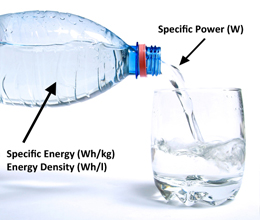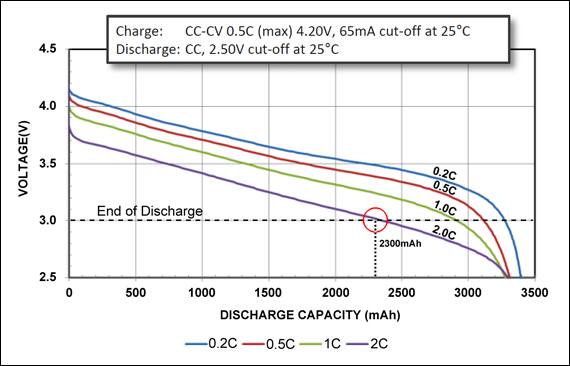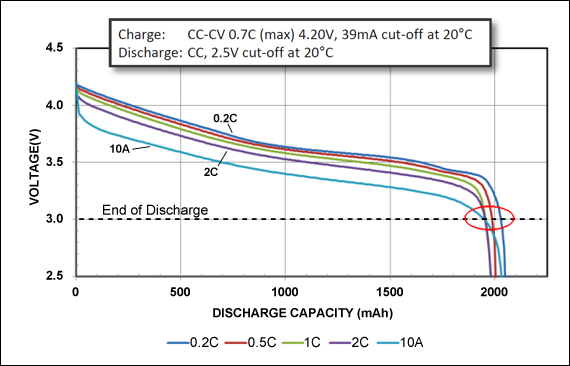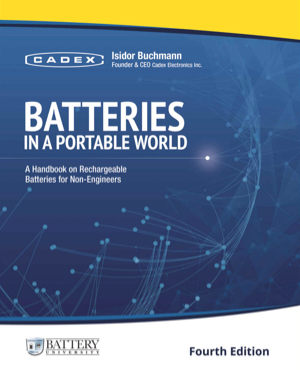There are more mobile phones in the world than people. No other products have taken off so quickly — faster than the automobile, television, the PC and the Internet. Advancing from a clunky and expensive box in the 1990s to a sleek touchscreen device, the mobile phone still has one troubling component; the battery. Improvements have not been as fast on the battery as with other developments and credit for long runtime goes mostly to advancements in electronics, software and infrastructure.
| A mobile phone battery must meet two requirements: High specific energy (capacity) and high specific power. Capacity refers to energy storage (Ah) analogous to the water in a bottle; specific power reflects in the ability to deliver current (A) representing the mouth opening of the bottle. Figure 1 demonstrates the relationship in the form of a water bottle. A mobile phone battery needs high capacity and reasonably good specific power. These are two unique attributes that cannot be put into one product without compromise. An analogy is political parties that pursue different mandates and must make a compromise. In the battery, specific energy is responsible for runtimes and specific power for current. |  Figure 1: Relationship between specific energy and specific power. |
The early Li-ion battery of the 1990s was fragile and unsuitable for high loads. This delayed the use of Li-ion in power tools and electric vehicles. These markets were reserved for the more rugged nickel-cadmium and later nickel-metal-hydride. Today lithium-based systems stand shoulder to shoulder with nickel and lead chemistries. This was made possible with the development of two types of Li-ion systems; the Energy Cell delivering maximum runtime and the Power Cell enabling heavy loading.
Energy Cell
The Li-ion Energy Cell has a high ampere-hours (Ah) rating for long runtimes and the Panasonic NCR18650B illustrated in Figure 2 is such a product. This cell delivers a capacity of 3,200mAh when discharged at 0.5C or 1.6A. The battery is delicate in that the capacity decreases to 2,300mAh when discharging at 2C or 6.4A. For purpose of analysis, the end-of-charge is set to 3.0V; the cutoff is marked with the red circle. (Ampere-hours with smaller batteries are given usually in milliampere-hours (mAh).)
The end-of-discharge cutoff for many devices, including the mobile phone, is often above the designated 3.0V; 3.3V is common. This reduces the usable capacity, especially if discharged at a high current. In many mobile phones, 3.3V refers to zero charge. Some phone may keep operating, others will close shop. Voltage recovery may allow short uses after a rest or when keeping the phone warm.

Figure 2: Discharge of 3,200mAh Energy Cell
Panasonic NCR18650B is discharged at 0.2C, 0.5C, 1C and 2C. The red circle marks early cutoff at 2C.
Cold temperature losses:
25°C (77°F) = 100%
0°C (32°F) = ~83%
–10°C (14°F) = ~66%
–20°C (4°F) = ~53%
Source: Panasonic
The Energy Cell should not be fast-charged at a higher rate than 1C; 0.8C or less is recommended to achieve the specified cycle count. Loading above 1C also adds stress, reflecting in reduced longevity. This cell is ideal for portable computing and mobile phone applications with light to moderate loading requiring long runtimes.
Power Cell
The Panasonic UR18650RX Power Cell in Figure 3 has a capacity that is 40% less than the Energy Cell, but has excellent loading capabilities. A 10A (5C) discharge has minimal capacity loss when referring to the 3.0V cutoff. This cell works well for applications requiring heavy load current, such as power tools.

Figure 3: Discharge of 1,950mAh Power Cell.
Panasonic UR18650RX is discharged at 0.2C, 0.5C, 1C and 2C and 10A, reaching the 3.0V/cell cut-off line at about 2000mAh in the red circle.
Cold temperature losses:
25°C (77°F) = 100%
0°C (32°F) = ~92%
–10°C (14°F) = ~85%
–20°C (4°F) = ~80%
Source: Panasonic
Further advantages of the Power Cell over the Energy Cell are faster charge times and improved low temperature performance. All batteries lose performance when cold but the Li-ion Power Cell overcomes this by providing 92% capacity at 0°C (32°F) and 80% at –20°C (4°F). In comparison, the Energy Cell drops to 83% at 0°C (32°F) and 53% at –20°C (4°F). Never charge Li-ion below freezing as this causes the plating of metallic lithium. This may go unnoticed but can compromise the safety of the battery.
The Power Cell achieves superior performance in part by optimizing the surface area of the active materials to enable high current flow with minimal temperature rise. Batteries for mobile phones are crossbred to achieve long runtime and provide the necessary loading capability during active use.
Relaxed Requirements
One of the major advantages of the mobile phone battery compared to other devices is the use of a single Li-ion cell. This simplifies the safety circuit and does not require cell matching as is necessary with multi-cell packs. This, however, opens the floodgates for broader performance tolerances. Most users would not notice a slightly shorter runtime of a battery that passes at the low-end of the bell curve.
Mobile phones come with built-in obsolescence to entice selling a new model when the battery fades or the glass cracks. Other products have stricter requirements in terms of battery longevity and the electric vehicle is an example. EV batteries are guaranteed for eight years; the replacement cost is as much as a regular economy car. Manufacturers can build batteries that last and much of this is achieved by avoiding full charges and complete discharges.
Mobile phones are made in large quantity and come with a customized pack. Standard sizes do not apply. Because of size restrictions the choices are most often prismatic or pouch. The popular 18650 cell finds applications in power tools, medical instruments, e-bikes and some EVs.
When the state-of-charge (SoC) gets low and the mobile phone approaches the cutoff voltage that is between 3.2–3.5V, the internal resistance of the battery rises. This causes the voltage drop further. The load current on a smartphone ranges from 0.6–1.9A. While talking may still be possible with low charge in close proximity to a tower, GPS and complex computing functions requiring higher operating current and the phone may cut off. Accessing a tower in a fringe area also requires more power than being in line-of-site. A bright display also consumes power. Table 4 estimates typical current consumptions of a modern smartphone.
| Application | Current draw |
| CPU usage low | 200mA |
| CPU usage high | 900mAh |
| Main camera active | 200mAh |
| Front camera active | 100mAh |
| WLAN enabled | 50mA |
| LCD backlighting | 100mAh |
| Total current draw | 600 to 1,900mA |
Figure 4: Current draw of a mobile phone.
Multiple applications are engaged when using our mobile phones that add to a total current draw for a given time. Some applications are momentary; others stay on as housekeeping functions.
Testing Mobile Phone Batteries
Capacity is the leading health indicator of a battery. Elevated internal resistance is also a failure mode but this is less common. Several methods can be used to estimate the state-of-health (SoH) of a battery.
Coulomb counting observes in and outflowing currents of a battery. The theory goes back 250 years when Charles-Augustin de Coulomb established the “Coulomb Rule” that equates one ampere (1A) per second as one coulomb. Coulomb counting measures the energy reserve and should give a fair estimation on the content. This method should be flawless but it has drawbacks. The energy drawn from the battery is always less than what is put in. Tracking errors occur by random use that accumulates over time. Coulomb counting works best when the phone is allowed to run down occasionally to enable calibration.
Apps are available to check battery SoH in mobile phones and laptops. This requires current sensing and not all mobile phones provide this feature. Experts examining the app method hint to inaccuracies. Cadex examined 20 batteries that had passed as good when tested with an app that was sold as a commercial product. Testing these batteries with a full cycle, the battery analyzer disclosed capacities ranging from 57–86% with internal resistance fluctuating from 155–368mOhm. With the capacity pass/fail threshold set to 80% and internal resistance to 200mOhm, only 5 of these 20 batteries would qualify for reusable.
Some mobile phone manufacturers include software tools that estimate battery SoH, but the readings are not made available to the general public and are only accessible to authorized personnel by security code. This is done for good reason. Making capacity readings available to the users could lead to high warranty claims, especially if the phones are not calibrated and the readings are skewed. A replacement is only mandatory if the battery capacity drops below 80 percent. Keeping the evidence hidden is least disruptive.
The most reliable method to check a battery is applying a full discharge cycle. Although time consuming, some refurbishing houses apply this method to get accurate readings with a printed performance report. With automated battery analyzers, the only labor is refilling the stations and the throughput is high. Storefront and small service centers prefer rapid test methods that give reasonable accurate results in just a few minutes. Rapid-testing takes a snapshot of the “chemical battery” rather than relying on the “digital battery” that is often fraught with tracking errors.
Most smartphones no longer provide access to the battery, but service centers and refurbishing houses still need to check them. This can be done by opening the devices and connecting the miniature connectors to the FlexStrip interface provided by the battery analyzer. Such work is no longer performed at storefront but by skilled technicians in a service environment.
References: W-Support GmbH, Germany. Axel Brandt
About the Author
Isidor Buchmann is the founder and CEO of Cadex Electronics Inc. For three decades, Buchmann has studied the behavior of rechargeable batteries in practical, everyday applications, has written award-winning articles including the best-selling book “Batteries in a Portable World,” now in its fourth edition. Cadex specializes in the design and manufacturing of battery chargers, analyzers and monitoring devices. For more information on batteries, visit www.batteryuniversity.com; product information is on www.cadex.com.

Comments
Looking for comments from the previous website?
Comments from the previous website are not compatible with our new commenting system but we have preserved them so our users can still reference and make use the information in them.
